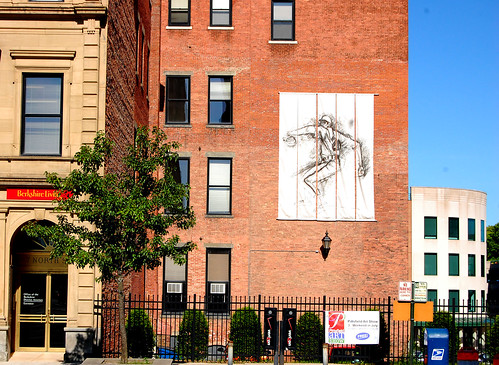
One of the summer's thrilling moments came last Saturday, when the Globe gave its A1 centerpiece to a story about Pittsfield's resurgence. Even if the Globe's coronation doesn't equal the cultural cache I always want to associate with, Pittsfield certainly deserves all the publicity that comes its way. It's also nice to be on the inside before it happens. As a friend jokingly told me in a text message Saturday, "You're famous." (Hopefully he doesn't dispute this one in the comments section.)
The city, about 42,000 people and declining in Massachusetts' western corner, is an intriguing mix of urban, rural and post-industrial, and of the poor and the reviving. The perennial fear of gentrifying neighborhoods, especially when stories like the Globe's are published, is the real estate market's upswing eventually drives away natives who no longer can afford them. Not so with Pittsfield. It's too remote, too cold, too quirky, too entrenched to become such a place -- at least in the next 25 years.
The number of struggling people I see when I walk everyday down North Street, Pittsfield's main downtown street, is astonishing. But then there are neat stores, galleries, a new cinema that played all of the Celtics playoff games and World Cup for free, restaurants and streets fairs, all of which the Globe cited as proof of the city's return. (In fact, I swear I've seen about eight new hipsters in the week since the story, including a new gallery, an attractive 20-something on a bicycle and a guy who looked like a Web programmer. Maybe they read the story too and promptly moved?) These two cultures exist jointly in a very natural, pleasant way -- attractive and seedy at the same time. It's one of the city's great charms.
Usually the commenters at the bottom of news stories are noxious, but this time they correctly identified Pittsfield's problems, which the Globe's reporter chose to polish nearly out of existence. Jobs are scarce, both for the educated and uneducated. Median household incomes are low. Health figures go in all the wrong directions, such as the teenage pregnancy rate, which has increased the past few years as the state's has declined. And, to return to urban planning, a city based solely on the arts isn't a well-rounded one. It's certainly a good start, but, as my boss told me recently, expressing his reservations about all of this, arts districts, particularly in out-of-the-way 21st-century places that also heavily rely on tourism, create lots of service jobs that might have luxurious patrons but don't pay luxurious wages, or anything close to them.
Placemaking, one of contemporary urban planning's most popular terms, is an amorphous concept best defined by experiencing it in the moment. It has something to do with promoting the local, nourishing the homegrown across all the industries where it's found, supporting entrepreneurship and community, and creating something distinct. This is a very tricky thing to do in the 21st century. Increasingly, I don't think the Boston-to-D.C. corridor has it (though any city has it when compared to a metropolitan area). But Pittsfield -- and all of the Berkshires -- have it and they should run with it. Whatever that means, however it happens.
No comments:
Post a Comment